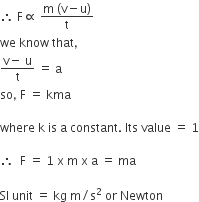CBSE
Class 10 Class 12
Momentum:
Momentum is the power of motion of an object.
The product of velocity and mass is called the momentum. Momentum is denoted by ‘p’.
Therefore, the momentum of the object = Mass x Velocity.
Or, p = m x v
Where, p = momentum, m = mass of the object and v = velocity of the object.
Consider the following explanations to understand the momentum :
Unit of momentum :
SI unit of mass = kg
SI unit of velocity = meter per second i.e., m/s
We know that Momentum (p) = m × v
Therefore, p = kg × m/s
Or p = kg m/s
Therefore, SI unit of momentum = kg m/s
Second Law of Motion
The rate of change of momentum of an object is proportional to applied unbalanced force in the direction of the force.
Mathematical expression
Suppose, Mass of an object = m kg
Initial velocity of an object = u m/s
Final velocity of an object = v m/s
So, Initial momentum, p1 = mu, Final momentum, p2 = mv
∴ Change in momentum = Final momentum – Initial momentum
= mv – mu
= m(v – u)
p = m(v - u)
∴ Rate of change of momentum = Change in momentum/Time taken
= m(v - u)/t
According to IInd law, this rate of change is momentum is directly proportional to force.
